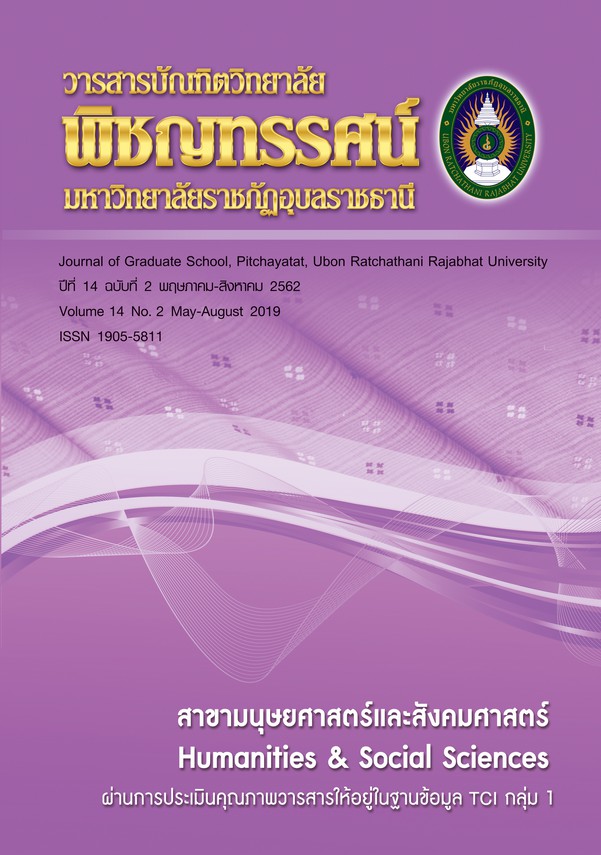เส้นใยกล้วยหอมทองย้อมสีธรรมชาติสำหรับใช้ในการทำเครื่องจักสาน
คำสำคัญ:
การย้อมสีธรรมชาติ, เส้นใยกล้วยหอมทอง, การเข้าเกลียวเส้นใยกล้วยบทคัดย่อ
การวิจัยนี้มีวัตถุประสงค์เพื่อ 1) ศึกษาคุณสมบัติของเส้นใยกล้วยหอมทอง 2) การย้อมเส้นใยกล้วยหอมทองด้วยสีย้อมธรรมชาติ และ 3) ศึกษาวิธีการนำเส้นใยกล้วยหอมทองไปทำผลิตภัณฑ์เครื่องจักสาน กลุ่มตัวอย่างที่ใช้ในการทดลอง คือ เส้นใยกล้วยหอมทองย้อมสีธรรมชาติจากเปลือกต้นสัตบรรณ ครั่ง ผลมะเกลือ ต้นคราม และเปลือกต้นประดู่ ทำการเปรียบเทียบวิธีการย้อม 2 วิธี คือ การย้อมร้อน และการย้อมเย็น วิธีการเตรียมเส้นใยสำหรับทำเครี่องจักสาน มี 2 แบบ คือ แบบเข้าเกลียว และแบบถักเปีย วางแผนการทดลองแบบสุ่มอย่างสมบูรณ์ (CRD) และเปรียบเทียบความแตกต่างของสถิติที่ใช้ในการวิเคราะห์ข้อมูล ได้แก่ ค่าเฉลี่ย และการทดสอบค่า t-test ผลการศึกษา พบว่า คุณสมบัติของเส้นใยกล้วยหอมทอง สามารถนำไปพัฒนาเป็นเครื่องจักสานได้ จากการใช้ส่วนลำต้นเทียบ โดยแกะกาบกล้วยมาขูดเส้นใยได้ 12 ชั้น ส่วนหยวกกล้วยไม่สามารถนำมาแยกเส้นใยได้ ความยาวของกาบกล้วยชั้นที่ 1-7 ไม่แตกต่างกัน ส่วนชั้นที่ 8-12 มีความยาวของกาบแตกต่างกัน จากการทดสอบน้ำหนักของกาบกล้วยหอมทองแต่ละชั้น พบว่า กาบกล้วยแต่ละชั้นมีน้ำหนักไม่แตกต่างกัน ซึ่งมีค่าเฉลี่ยของน้ำหนักอยู่ระหว่าง 231.03–239.01 กรัม ขนาดของเส้นใย ความคงทนต่อแรงดึง และค่ายังโมดูลัสของเส้นใยไม่แตกต่างกัน ค่าแรงต้านทานภายในของกาบชั้นที่ 4 มีความแตกต่างกับกาบชั้นอื่นๆ กาบที่ 1 มีค่าความคงทนต่อแรงดึงมากที่สุด กาบที่ 4 มีค่ายังโมดูลัสมากที่สุด การย้อมเส้นใยกล้วยหอมทอง พบว่า เส้นใยกล้วยสามารถติดสีย้อมได้ทุกชนิด สีที่ได้จากวิธีการย้อมร้อน และย้อมเย็นให้เฉดสีเดียวกัน แต่มีความสว่างของสี และความสดของสี แตกต่างกัน โดยสีย้อมจากเปลือกต้นสัตบรรณ และครามเปียก ที่ย้อมด้วยวิธีการที่ต่างกันให้สีไม่แตกต่างกัน ส่วนสีย้อมจากครั่ง ผลมะเกลือ และเปลือกต้นประดู่ ที่ย้อมด้วยวิธีการที่ต่างกันให้สีที่แตกต่างกัน สำหรับการนำเส้นใยกล้วยหอมทองไปทำเครื่องจักสาน ทำได้โดยนำเส้นใยมารวมกันจำนวน 15-20 เส้น เพื่อให้เส้นใยให้มีขนาดใหญ่ขึ้น ด้วยใช้วิธีการเข้าเกลียว หรือการถักเปีย ก่อนนำไปทำผลิตภัณฑ์เครื่องจักสานโดยใช้เทคนิคต่างๆ
เอกสารอ้างอิง
พูลสุข บุณยเนตร. วิทยาศาสตร์สิ่งทอ. คณะวิทยาศาสตร์และเทคโนโลยี: มหาวิทยาลัย ราชภัฏเชียงใหม่, 2553.
พัฒนาอุตสาหกรรมสิ่งทอ, สถาบัน. เส้นใยกล้วย (Abaca) และป่านสับปะรด(Henequen). (ออนไลน์). ม.ป.ป. (อ้างเมื่อ 6 ธันวาคม 2560). จากhttps://www.thaitextile.org/index.php/blog/2016/08/59plant9
เพชร ธุระวร. กระบวนการพัฒนาและสืบทอดภูมิปัญญาการย้อมสีด้ายด้วยวัสดุธรรมชาติของผู้หญิงกะเหรี่ยงสะกอ ตำบลแม่ยาว อำเภอเมือง จังหวัดเชียงราย. (ออนไลน์) 2544 (อ้างเมื่อ 19 กันยายน 2560). https://elibrary.trf.or.th/project_conte ntTRFN.asp?PJID=RDG44N0043
รุ้ง ปิ่นคำ. การปลูกกล้วยหอมทองของบ้านช่อแล. (การสัมภาษณ์) เจ้าของสวนลุงตู่กล้วยหอม ทอง อำเภอแม่แตง จังหวัดเชียงใหม่, 24 กรกฎาคม 2557.
วิบูลย์ ลี้สุวรรณ. เครื่องจักสารในประเทศไทย. กรุงเทพฯ: โอ. เอส. พริ้นติ้ง เฮ้าส์, 2539.
ศิลปากร, มหาวิทยาลัย. ผ้าทอพื้นเมืองในภาคกลาง. กรุงเทพฯ: อมรินทร์พริ้นติ้งแอนด์พับลิชชิ่ง. 2543.
สุปราณี แก้วภิรมย์และคณะ. คอมโพสิตรักษ์สิ่งแวดล้อมจากพอลิแลคติกแอซิดและเส้นใยสับปะรด. (ออนไลน์) 2557 (อ้างเมื่อ 19 กันยายน 2560). จาก https://digital_collect.lib. buu.ac.th/dcms/files//2559_065
สิ่งแวดล้อม, สำนักงาน . รู้จักผลิตภัณฑ์และ บริการที่เป็นมิตรต่อสิ่งแวดล้อม. (ออนไลน์) 2556 (อ้างเมื่อ 19 พฤษภาคม 2560). จาก https://bangkokgreencity.bangkok.go.th/
Mekel, A. N., Soenoks, R., Suprapto, W. and Purnowidodo, A. Tensile Strength of Abaca Strands from Sangihe Talaub Islands. ARPN Journal of Engineering and Applied Sciences. 11, 15 (August 2014): 9487-9490.
Basu, S. Tensile Deformation of Fibers Used in Textile Industry. (Online) 2012 (Cited April 19, 2017). Available from: https://cp.literature.agilent.com/ litweb/pdf/5991-0274EN.pdf
Needles, H. L. Textile fibers, dyes, finishes and processes. Standard Publishers Distributors: Delhi, 2001.
Vijayalakshmi, K., Neeraja, Ch. Y. K., Kavitha. A. and Hayavadana, J. Abaca Fibre. Transactions on Engineering and Sciences. 2, 9 (September, 2014): 16-19.
ดาวน์โหลด
เผยแพร่แล้ว
รูปแบบการอ้างอิง
ฉบับ
ประเภทบทความ
สัญญาอนุญาต
ลิขสิทธิ์ (c) 2019 มหาวิทยาลัยราชภัฏอุบลราชธานี

อนุญาตภายใต้เงื่อนไข Creative Commons Attribution-NonCommercial-NoDerivatives 4.0 International License.
บทความทุกเรื่องได้รับการตรวจความถูกต้องทางวิชาการโดยผู้ทรงคุณวุฒิภายนอกอย่างน้อย 2 คน ความคิดเห็นในวารสารบัณฑิตวิทยาลัย พิชญทรรศน์ มหาวิทยาลัยราชภัฏอุบลราชธานี เป็นความคิดเห็นของผู้เขียนมิใช่ความคิดเห็นของผู้จัดทำ จึงมิใช่ ความรับผิดชอบของบัณฑิตวิทยาลัย มหาวิทยาลัยราชภัฏอุบลราชธานี และบทความในวารสารบัณฑิตวิทยาลัย พิชญทรรศน์ มหาวิทยาลัยราชภัฏอุบลราชธานี สงวนสิทธิ์ตามกฎหมายไทย การจะนำไปเผยแพร่ต้องได้รับอนุญาตเป็นลายลักษณ์อักษรจากกองบรรณาธิการ






